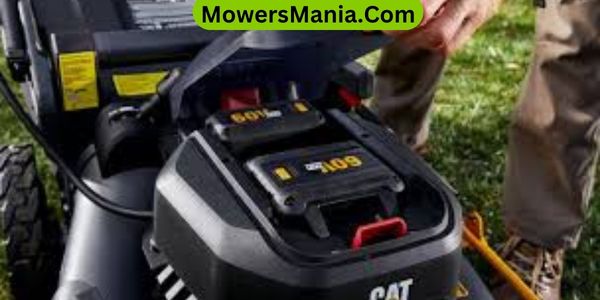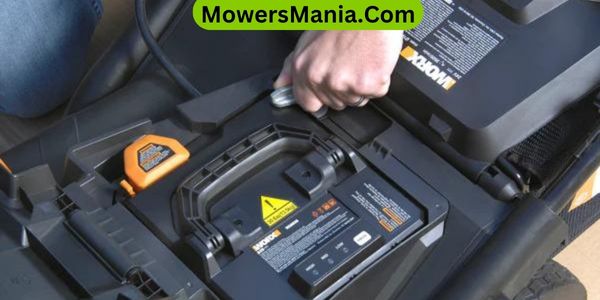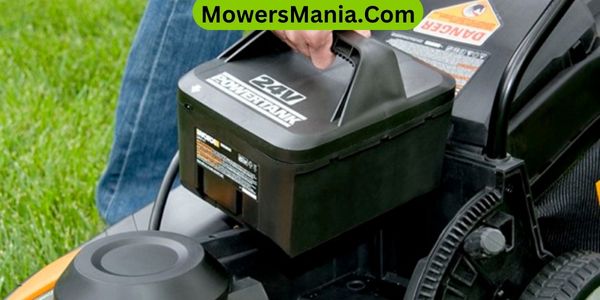Is your lawn mower battery losing charge quickly, leaving you frustrated with frequent replacements?
Regular maintenance can help extend its lifespan. For example, a neighbor’s battery, left unattended during the winter, became completely drained and wouldn’t hold a charge.

By following simple maintenance tips, you can avoid similar issues and keep your lawn mower running smoothly.
Understanding Your Battery
To understand your lawn mower battery’s maintenance needs, it’s essential to grasp the basics of its construction and function.
The typical lawn mower battery is a 12-volt lead-acid battery, similar to those found in cars. It consists of six cells, each producing 2.1 volts, connected in series to generate the total 12 volts. The battery is encased in a durable plastic housing, protecting it from moisture and vibrations.
Understanding the function is equally important. When you start your lawn mower, the battery provides the initial electrical current to power the starter motor, igniting the engine. Once the engine is running, the alternator takes over to recharge the battery. This cycle repeats each time you mow the lawn.
Knowing these basics will help you comprehend why proper maintenance is crucial for your lawn mower battery’s longevity and performance.
Simple practices like regular cleaning, checking the electrolyte levels (if applicable), and ensuring secure connections can significantly extend the battery’s life. Understanding how your battery works will empower you to take the necessary steps to keep it in optimal condition.
Checking and Cleaning Connections

When maintaining your lawn mower battery, begin by inspecting and cleaning the connections to ensure optimal performance and longevity.
Over time, corrosion and debris can build up on the battery terminals and cable connections, leading to poor electrical conductivity and reduced battery life.
Follow these simple steps to check and clean the connections:
| Steps to Follow | Tools Needed | Time Required |
|---|---|---|
| Inspect connections | Safety gloves | 5 minutes |
| Clean terminals | Battery terminal brush | 10 minutes |
| Check cable ends | Wire brush | 5 minutes |
| Tighten loose cables | Adjustable wrench | 5 minutes |
Regularly checking and cleaning the connections will ensure that your lawn mower battery operates efficiently and lasts longer. It’s a quick and easy task that can save you from potential starting issues and costly replacements down the line.
By investing a small amount of time in maintenance, you can keep your lawn mower running smoothly and your yard looking its best.
Proper Charging Techniques
When charging your lawn mower battery, it’s important to follow some best practices to ensure its longevity.
Avoid overcharging the battery, as this can lead to issues and reduce its overall lifespan.
Charging Best Practices
You should always fully charge the lawn mower battery before using it for the first time after winter storage. This helps to ensure optimal performance and longevity.
To properly charge the battery, follow these best practices:
- Use a charger specifically designed for lawn mower batteries to avoid overcharging or undercharging.
- Charge the battery in a well-ventilated area to prevent the buildup of potentially explosive gases.
- Connect the charger to the battery following the correct polarity to avoid damage to the electrical system.
- Monitor the charging process and disconnect the charger once the battery is fully charged to prevent overcharging and potential damage.
Following these charging best practices will help extend the life of your lawn mower battery and ensure reliable performance.
Prevent Overcharging Issues
To prevent overcharging issues, ensure that you use a charger specifically designed for lawn mower batteries. Using a charger with the correct voltage and current output is crucial to prevent overcharging, which can damage the battery.
When charging the battery, always follow the manufacturer’s recommended charging times. Avoid leaving the battery on the charger for extended periods, as this can lead to overcharging. Once the battery is fully charged, disconnect it from the charger to prevent any risk of overcharging.
It’s important to periodically check the charger to ensure it’s functioning properly and not overcharging the battery. By following these proper charging techniques, you can effectively prevent overcharging issues and prolong the life of your lawn mower battery.
Avoiding Overcharging and Undercharging

To maintain your lawn mower battery, ensure that you neither overcharge it nor let it become fully discharged, as both can shorten its lifespan.
Overcharging can lead to excessive heat buildup and water loss, while allowing the battery to become fully discharged can cause sulfation, reducing its capacity over time.
Here’s how to avoid overcharging and undercharging:
- Use a battery maintainer: Invest in a quality battery maintainer with automatic shutoff to prevent overcharging and keep the battery at an optimal level when not in use.
- Regularly inspect the battery: Check the battery’s water levels and connections to ensure proper maintenance and prevent overcharging or undercharging issues.
- Follow the manufacturer’s guidelines: Adhere to the manufacturer’s recommendations for charging intervals and methods to prevent overcharging or undercharging the battery.
- Avoid deep discharging: Try not to let the battery become fully discharged, as this can lead to sulfation and reduce its overall lifespan.
Storing the Battery in Off-Season
During the off-season, when your lawn mower isn’t in use, it’s important to properly store the battery to maintain its longevity and performance.
Start by fully charging the battery before storing it.
Clean the battery terminals and cables with a mixture of baking soda and water to prevent corrosion. Once clean and dry, disconnect the battery from the mower and store it in a cool, dry place away from direct sunlight and extreme temperatures.
It’s essential to check the battery periodically during the off-season to ensure it maintains a sufficient charge. Consider using a battery maintainer or trickle charger to keep the battery at an optimal charge level.
Avoid storing the battery directly on concrete floors, as it can lead to discharging.
Troubleshooting Common Issues

If your lawn mower battery is experiencing common issues, you can troubleshoot them by checking the connections and testing the voltage.
Start by ensuring that the battery terminals are clean and tightly connected. Loose or corroded connections can prevent the battery from delivering power to the mower.
Once the connections are secure, use a multimeter to test the battery voltage. A fully charged 12-volt battery should read around 12.6 to 12.8 volts. If the voltage is significantly lower, it may indicate that the battery needs to be recharged or replaced.
Troubleshooting Checklist:
- Check Connections: Ensure that the battery terminals are clean and securely attached to the mower.
- Test Voltage: Use a multimeter to measure the battery voltage and verify if it’s within the normal range.
- Recharge the Battery: If the voltage is low, recharge the battery using an appropriate charger.
- Consider Replacement: If the battery fails to hold a charge or consistently shows low voltage readings, it may be time to replace it.
Frequently Asked Questions [FAQs]
Can I Use a Regular Car Battery Charger to Charge My Lawn Mower Battery?
Yes, you can use a regular car battery charger to charge your lawn mower battery. Just make sure to use a charger with a lower amp setting, and follow the manufacturer’s guidelines for charging.
Is It Safe to Leave My Lawn Mower Battery Connected to the Charger for an Extended Period of Time?
Yes, it’s safe to leave your lawn mower battery connected to the charger for an extended period of time, but check the manufacturer’s guidelines. Overcharging can damage the battery, so ensure you follow the recommended charging times.
What Is the Average Lifespan of a Lawn Mower Battery and When Should I Consider Replacing It?
On average, a lawn mower battery lasts 3-4 years. However, if you notice decreased performance or difficulty starting your mower, it may be time for a replacement. Regular maintenance and proper charging can extend its lifespan.
How Can I Prevent My Lawn Mower Battery From Losing Power During the Off-Season?
To prevent your lawn mower battery from losing power during the off-season, you should disconnect the battery and store it in a cool, dry place. Regularly charge it to maintain its power and consider using a battery maintainer.
Are There Any Specific Maintenance Tasks I Should Perform on My Lawn Mower Battery to Prolong Its Lifespan?
To prolong your lawn mower battery’s lifespan, perform regular maintenance tasks. Keep the terminals clean, check water levels if applicable, and charge the battery fully before storage. These steps will help prevent power loss during the off-season.
Conclusion
Now that you know how to maintain your lawn mower battery, you can ensure that it stays in good condition for longer.
By understanding your battery, checking and cleaning connections, using proper charging techniques, and storing it properly in the off-season, you can avoid common issues and keep your lawn mower running smoothly.
With these simple steps, you can extend the life of your battery and enjoy a well-maintained lawn all year round.



